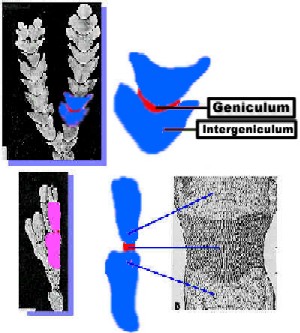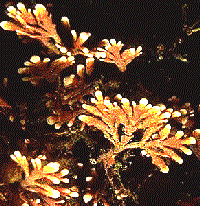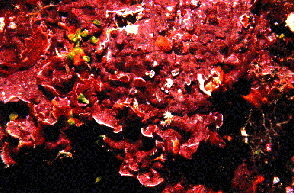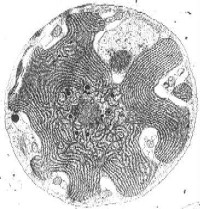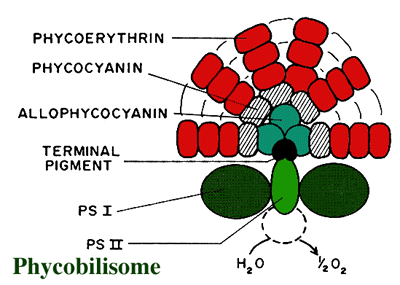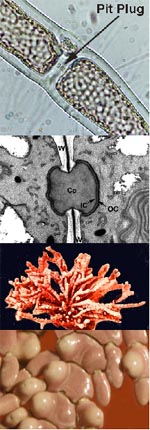|

|
- Nuclear envelope remains intact during mitosis
- Nuclear associated organelle (NAO) or polar ring substitutes for lacking centrioles
- NAO appear as hollow cylinders, which organize the division spindle; chemical structure and function unknown, but microtubuli are associated
- Daughter nuclei are kept separate by large chloroplast or central vacuole (multi-plastid species)
- Completion of cell division occurs only in tetraspore formation, vegetative cells exhibit incomplete cell division with pit plug formation
- Primary pit plugs are found between related cells
- Secondary pit plugs can be formed between non-sister cells; produced by unequal cell division with primary pit plug formation; then, the smaller cell fuses with adjacent non-sister cell
- Function: communication between genetically different cells and structural integrity among filaments

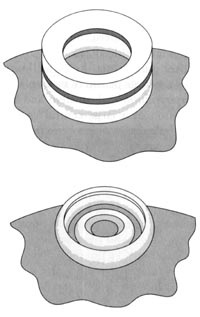
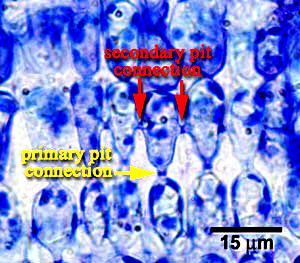
- Nuclear mitosis without cell division in many higher organized red algae produces long, multinucleate cells
- Number of nuclei is correlated to number of plastids within cells
- Endoreduplication: repeated genome duplication without mitotic nuclear division, resulting in polyploid nuclei
- Polyploidy is thought to buffer against mutation of essential genes
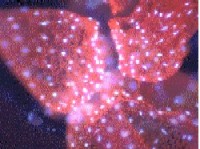
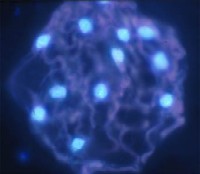
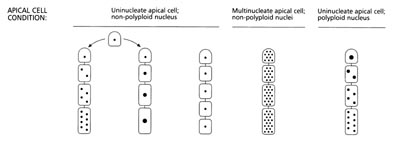
- Cell growth by elongation: Cells of Ceramium can increase from 4 µm to 420 µm – a 100-fold increase in cell length and a 14,000-fold increase in cell volume; in Lemanea, cells increase from 8 µm to 8 mm, a 1000-fold increase in length and 44,000-fold increase in volume
- Cell growth occurs only at the base of the cell
- Cell death in the middle of a filament triggers cell division in adjacent cells, which form daughter cells with rhizoid-like form; these cells grow towards each other and eventuall fuse to repair the filament
- Wound repair hormons seem to be involved in most studied species (rhodomorphin)
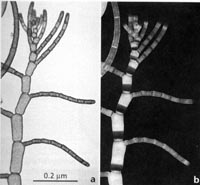
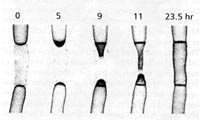
- Apical cell occur in most species as localized division site at the end of a filament
- Peraxial cells below the apical cell divide several times radially to branch filaments, each branch with a new apical cell; sub-apical cells also produce rhizoids = single filaments for thallus attachement
- Simple model: apical cell produces a central, axial filament of individual elongate cells. "Primary" branches produced along the central filament
- Model 2: same as above except many branches that form next to each other along the central filament („secondary" branches); cell fusions make separate branches appear as one structure
- Equal branch growth: all branches reach same length; adjacent cells can fuse to produce a laminar sheet
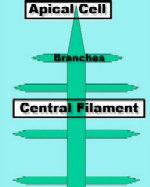
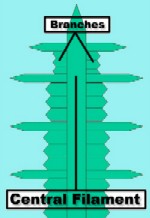
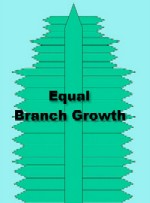
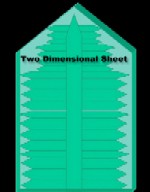
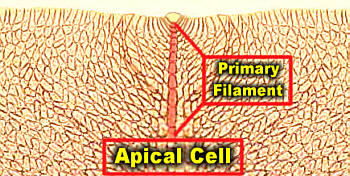
Note apical cell and central primary filament; cells in the lamina originate from branches that have fused
- Apical cell produces central filament
- Central filament produces branches
- Branches produce further sub-branches, whose cells might fuse laterally
- Cell size decreases with each successive branch, so that cells are smallest at the surface of the thallus (false epidermis)
- Differentiation in central medulla and peripheral cortex
- Multiaxial thalli possess several central filaments, each with an apical cell
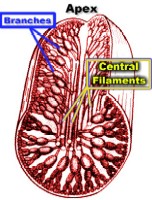
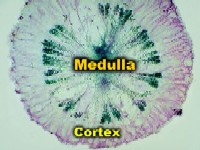
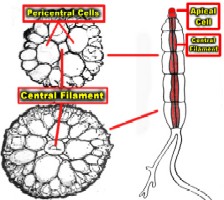
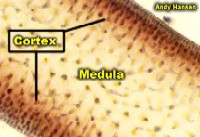
- Biphasic life cycle occurs in evolutionary early species
-
Triphasic
life cycle is unique to evolutionary young
red algae
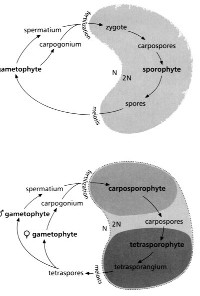
- Life cycles can change in some species, e.g. Porphyra: monospore, aplanospores, gametophyte (sexual reproduction)
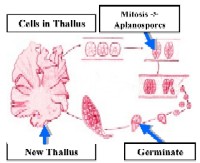
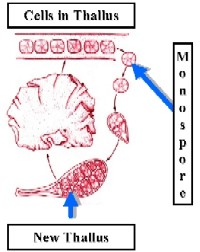
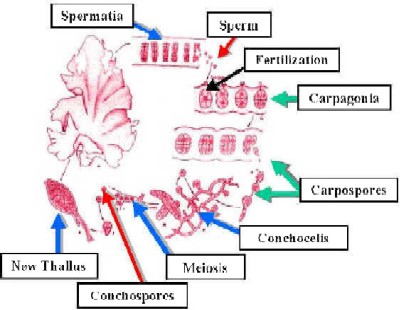
- Oogamy occurs in all red algae
- Carpogonium: larger, non-flagellate female gamete produced in carpogonia on female gametophyte
- Carpogonia are produced at the tip of special branches (carpogonial branches); typically flask-shaped with long, thin neck called trichogyne
- Spermatium: non-flagellate male gamete produced in spermatangium on male gametophyte; spermatia move passively (currents) to carpogonia
- Fertilization: spermatium fused with tip of trichogyne; a channel is enzymatically opened to allow the spermatium‘s nucleus to enter
- Carpospores: several diploid spores produced by mitosis of the zygote
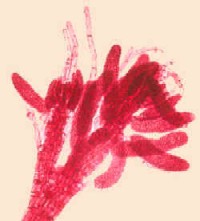
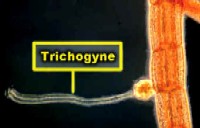
- Bangiophyceans
- Carpospores are released, settle, and grow into an independent sporophyte
- Conchocelis phase: filamentous sporophytes were regarded as different species (Conchocelis) living in mollusc shells or greater depths than the gametophytes
- Conchospores are released by the sporophyte (diploid!)
- Meiosis occurs upon germination of conchospores, producing 4 haploid cells, two male, two female
- Bangiophycean thalli contain mosaic of male and female cells or male and female sectors, arising from mitotic divisions of the original four haploid cells
- Florideophyceans
- Fertilized carpogonium produces diploid carposporophyte instead of carpospores: triphasic life-cycle!
- Carposporophyte produces and releases carpospores; carposporophytes always live on the female gametophyte and receive nutrients from the gametophyte
- Cystocarp is the single carposporophyte plus the gametophyte tissues surrounding and protecting it; the gametophyte tissue is separated into a photosy thetic outer layer (pericarp) and a colorless inner layer
- Each fertilized carpogonium can produce several cystocarps due to nuclear transfers among connected filament cells
- Carpospores grow into a second, multicellular, diploid generation, the tetrasporophyte
- Tetrasporophyte produces tetraspores in tetrasporangia
- Meiosis occurs upon germination of tetraspores, producing haploid gametophytes again
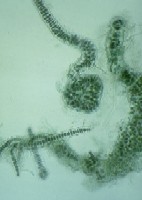
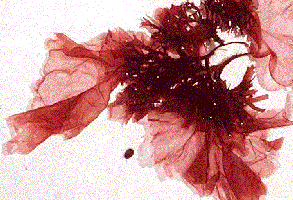
left: Bangia; right: Porphyra

Life cycle of Porphyra
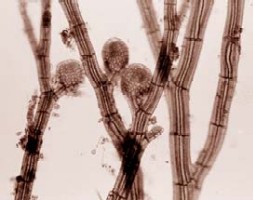
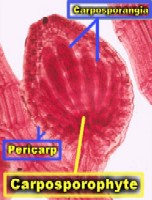
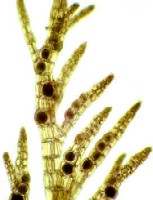

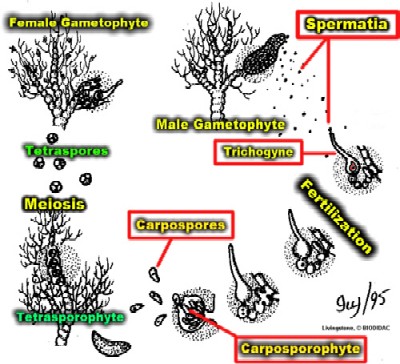
- Precipitate calcium carbonate in their outer cell wall layers;
- Rigid extracellular matrix that contributes to the formation of coral reefs.
- Two general types based on their morphology:
- Geniculate: branched and flexible due to the presence of genicula between rigid intergeniculate segments.
- Non-Geniculate: encrusting; some produce small foliose branches, while others are nodular.
